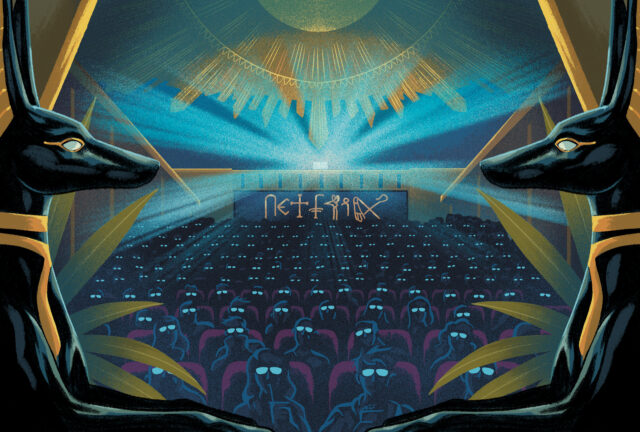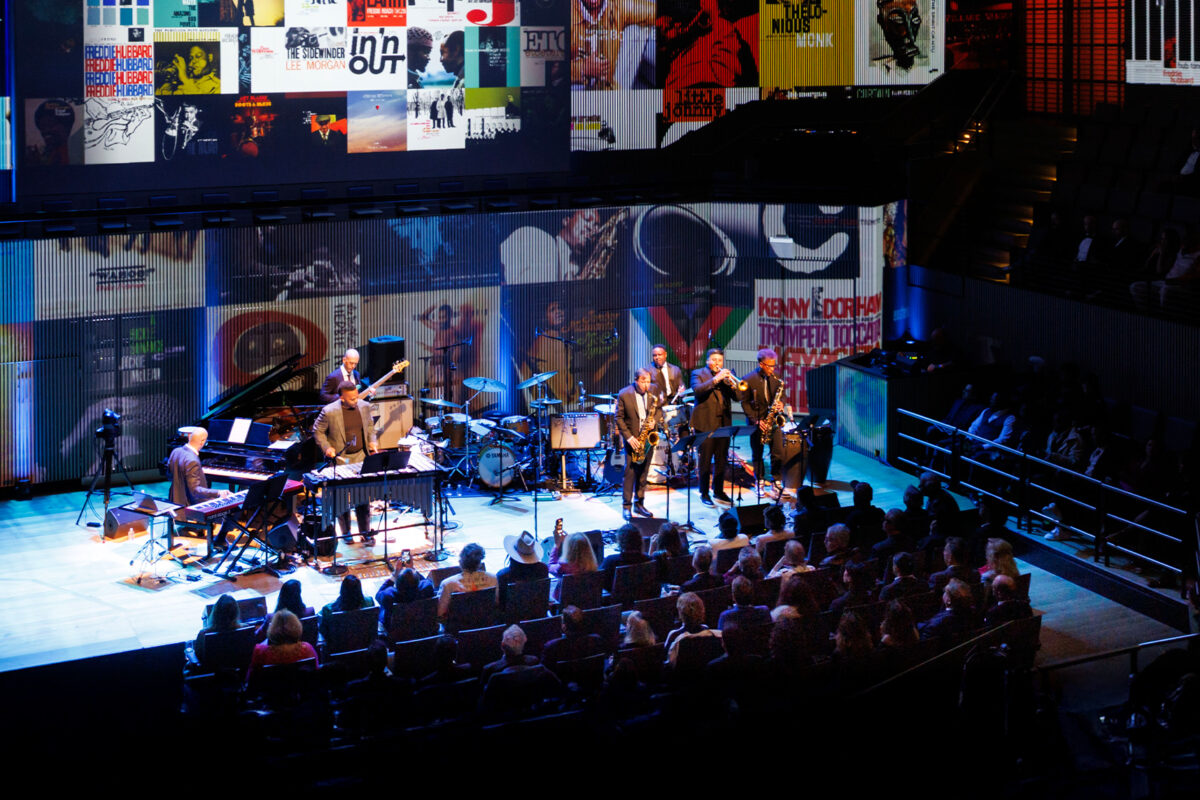Hollywood wouldn’t exist without its theaters. So who is coming to their rescue?
Words by LESLEY M. M. BLUME
Illustration by DEREK CHARM
Movie theater owner Sid Grauman hardly had a glittering origin story: In the early 1900s, his marquee was a makeshift tent filled with discarded church pews. Yet on October 18, 1922, he presided over an unprecedented spectacle unlike any in history: the premiere of Robin Hood, starring one of Hollywood’s first global megastars, Douglas Fairbanks, who preened on a red carpet for a press scrum in front of a legion of fans. Bright searchlights scanned the sky above. This brouhaha took place at the most American of inventions: a brand-new movie palace called the Egyptian Theatre, founded by Grauman.
When conjuring the theater, Grauman admittedly borrowed from history and a faraway culture: Thousands of miles away, a much-publicized search for King Tut’s tomb in the Egyptian desert had set off a craze in America for “Egyptian revival” décor and embellishments. The Egyptian had accordingly been built to resemble a temple resplendent with hieroglyphic murals, palm trees, and pharaoh head sculptures. An enormous gold scarab crowned the proscenium.
This past fall, the latest rebirth of the Egyptian was celebrated with similar fanfare. Its new owner is Netflix, the DVD-vendor-turned-streamer-turned-powerhouse-studio, which just undertook a$70 million restoration of the theater. By 2020, the building’s previous owners and caretakers, the nonprofit American Cinematheque, had been putting “almost all of their efforts into keeping the building from falling over,” says Netflix co-CEO Ted Saranos. The theater remains, in his opinion, “as important to the history of Hollywood as the Hollywood sign.”
Netflix’s goal, says Peyton Hall, a historical architect who consulted on the project, was to restore the Egyptian to its 1922 glory while installing state-of-the-art film and audio equipment. The overhaul involved a massive structural and seismic retrofitting using tons of concrete, but the meticulous restoration team also attended to the most minute design details. The auditorium’s sprawling ceiling sunburst and scarab was lovingly restored; the hieroglyphic murals and art were painstakingly repainted. An archaeological study of the murals themselves had been commissioned to decipher their original 1922 colors; Netflix even hired an Egypt historian to input on the project.
When the theater reopened in November, the restoration was widely lauded as an outsize success. Yet an uncomfortable question remains: After the initial fanfare dies down, can the Egyptian — or any of the other characterful landmark theaters in Los Angeles, for that matter — continue to bring in enough crowds to ensure its continued survival in the golden era of streaming? Netflix’s role as the Egyptian’s savior is an irony that has been lost on few commentators. In an early story on the restoration, Los Angeles Times columnist Glenn Whipp likened the streaming giant to a “destroyer of worlds.” Perhaps that was a bit extreme, he conceded, and then clarified: “Streaming, for many in the business, is just the destroyer of movies.”
The longish list of recently resurrected historic Los Angeles movie theaters seems to signify good news, at least in terms of architectural preservation. “It’s not a trend, but a movement,” says Hall, citing major restoration projects starting in the 1980s. “The Los Angeles Theatre, the Pantages, El Capitan, the Egyptian — hundreds of millions of dollars have been spent. A lot was spent on the Chinese Theatre, converting it to IMAX. There’s reason to be very pleased and optimistic.”
Historians point out that surviving landmark theaters have already weathered waves of other threats
There have, of course, also been theater near-deaths and casualties. Among the more prominent: the Cinerama Dome movie theater, which opened in 1963 and was shuttered during the pandemic. Its abrupt closure delivered a gut punch to the city’s film lovers and seemed to drive home the existential threat to theaters. Despite reports that it may reopen in 2025, the theater’s fate remains on many Angelenos’ worry list.
Yet the brave and the bold continue in their theater-lifesaving efforts, betting that younger generations will grow weary of exclusively watching entertainment at home on smaller screens. Brain Dead Studios has opened a repertory cinema in a former silent movie theater on Fairfax Avenue in West Hollywood. Filmmaker Quentin Tarantino, who bought and reoutfitted the New Beverly Cinema in 2007, also recently purchased the historic Vista Theatre in Los Feliz, a single-screen cinema that opened in 1923. (Like the Egyptian, the Vista’s interior appears to be a dramatically lit, King Tut–inspired theme park of sorts.) Following a three-year renovation, the Vista reopened last November with a screening of True Romance, shown on 35mm film. (Tarantino’s theaters would continue to show movies on film, he has said, “as long as I’m alive, and as long as I’m rich.”) The theater will also show new releases.
Ownership of single-screen cinemas might seem like an especially risky proposition, but Tarantino says he’s optimistic about the future of moviegoing. “I do think boutique cinemas will actually thrive at this time,” he said in a recent podcast interview. “I got a living room. I want to go to a movie theater.”
Historians point out that surviving landmark theaters have already weathered waves of other existential threats over the past century. “It’s always been a losing battle for movie theater owners to keep up,” says historian, architect, and filmmaker James Sanders. The invention of cinema sound quickly winnowed out a generation of 1920s silent film theaters that could not upgrade their technology. The 1950s introduced a new, terrifying rival: the home television set. More historic theaters closed as “the pictures got small,” as has-been silent film star Norma Desmond put it in Sunset Boulevard. Subsequent decades brought in additional challenges, such as the advent of cable television and multiplex movie compounds in the 1980s. The COVID-19 pandemic and streaming are just the latest assaults.
If many industry observers were playing taps for postpandemic moviegoing, certain events in 2023 seemed to jolt the whole enterprise back to life. It turned out to be a big, fat year for many theaters, with much of that very-welcome momentum credited to the Barbenheimer phenomenon. (Barbie has grossed nearly $1.5 billion globally at time of writing, and Oppenheimer nearly $1 billion.)
“Moviegoing isn’t dead; it’s just been dormant in many people’s lives,” says film historian and critic Leonard Maltin. The success of films like Barbie and Oppenheimer show that movies remain a tenable, even highly lucrative business, he adds — and still have the potential to create cultural flashpoints. “If you wanted to be part of the conversation on Monday morning, you’d better have seen Oppenheimer, and in order to do that, you had to go to an old-fashioned theater.”
As they hope for more blockbuster fare and a continued strengthening of the public’s appetite for moviegoing, owners of L.A.’s historic theaters will also continue to rely on the primary enticement that their predecessors created more than a century ago: an immersive, transporting experience in a physical space cut off from the bustle and reality of daily life.
“Loew’s Theatres founder Marcus Loew once said, ‘We don’t sell tickets to movies; we sell tickets to theaters,’” says Maltin. “The show begins on the sidewalk. You step outside your ordinary frame of reference into a magical environment. By setting foot inside a theater like the Egyptian, you transcend the mundane.”
This story originally appeared in the Spring 2024 issue of C Magazine.
Discover more CULTURE news.
See the story in our digital edition




